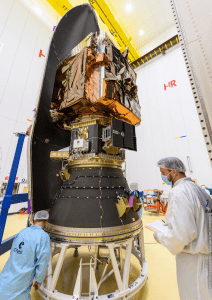TORONTO, Ontario, Canada – The Norwegian Space Agency has announced the successful launch of the NorSat-3 maritime tracking microsatellite built by Space Flight Laboratory (SFL) in Toronto. NorSat-3 launched on April 28, 2021, aboard Vega Flight VV 18 from the Guiana Space Center in French Guiana.

Vega VV18 upper stage being prepared for launch, with the NorSat-3 microsatellite visible, with flat solar panels, on the lower right. (Courtesy Arianespace)
NorSat-3 is the 17th SFL satellite launched in the past eight months.
“SFL congratulates Norway on its leadership in space-based maritime traffic monitoring,” said SFL Director Dr. Robert E. Zee. “NorSat-3 was contacted shortly after launch and is healthy. Commissioning is underway.”
NorSat-3 carries two instrument payloads. The primary device is an Automatic Identification System (AIS) receiver which acquires messages from civilian maritime vessels to provide information on ship locations and marine traffic. The microsatellite is also equipped with an experimental navigation radar detector developed by the Norwegian Defence Research Establishment (FFI) to augment the AIS receiver.
Combining a navigation radar detector and AIS receiver will potentially provide much better maritime awareness for the Norwegian Coastal Administration, Armed Forces, and other maritime authorities. Detections of navigation radar from ships will provide the ability to verify the accuracy of received AIS messages and to detect ships whose AIS messages have not been received.
SFL developed the 16.5-kg NorSat-3 microsatellite on its space-proven Next-generation Earth Monitoring and Observation (NEMO) platform under contract to Norwegian Space Agency with funding from the Norwegian Coastal Administration. SFL also built the NorSat-1 and -2 maritime tracking microsatellites now in orbit and is currently developing the NorSat-TD (Technology Demonstrator) satellite slated for launch in 2022.
Other launches of SFL-built satellites in just the past eight months include missions developed for the Dubai-based Mohammed Bin Rashid Space Centre (MBRSC) in the United Arab Emirates, GHGSat Inc. of Canada, HawkEye 360 of the U.S., Space-SI of Slovenia, and a Canada-based telecommunications company.
SFL is a unique microspace provider that offers a complete suite of nano-, micro- and small satellites – including high-performance, low-cost CubeSats – that satisfy the needs of a broad range of mission types from 3 to 500 kilograms. Dating from 1998, SFL’s heritage of on-orbit successes includes 69 satellites and distinct missions related to Earth observation, atmospheric monitoring, ship tracking, communication, radio frequency (RF) geolocation, technology demonstration, space astronomy, solar physics, space plasma, and other scientific research.
In its 23-year history, SFL has developed CubeSats, nanosatellites, and microsatellites that have achieved more than 144 cumulative years of operation in orbit. These microspace missions have included SFL’s trusted attitude control and, in some cases, formation-flying capabilities. Other core SFL-developed components include modular (scalable) power systems, onboard radios, flight computers, and control software.
About Space Flight Laboratory (SFL) (www.utias-sfl.net)
SFL generates bigger returns from smaller, lower cost satellites. Small satellites built by SFL consistently push the performance envelope and disrupt the traditional cost paradigm. Satellites are built with advanced power systems, stringent attitude control and high-volume data capacity that are striking relative to the budget. SFL arranges launches globally and maintains a mission control center accessing ground stations worldwide. The pioneering and barrier-breaking work of SFL is a key enabler to tomorrow’s cost aggressive satellite constellations. (www.utias-sfl.net)
Download the specification sheet for all SFL platforms here.
Dr. Robert E. Zee
SFL Director
1-416-667-7400
Follow SFL on Twitter @SFL_SmallerSats